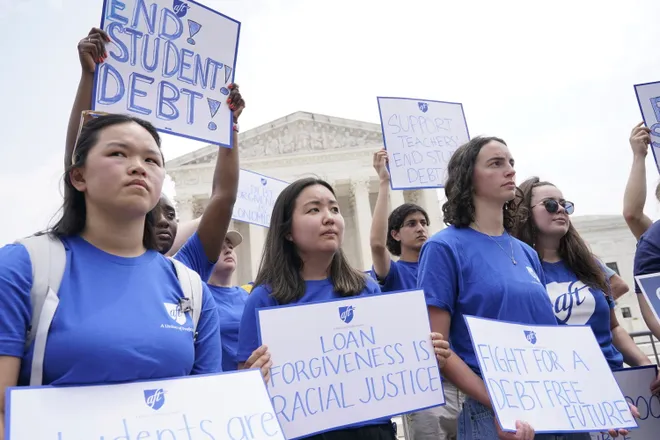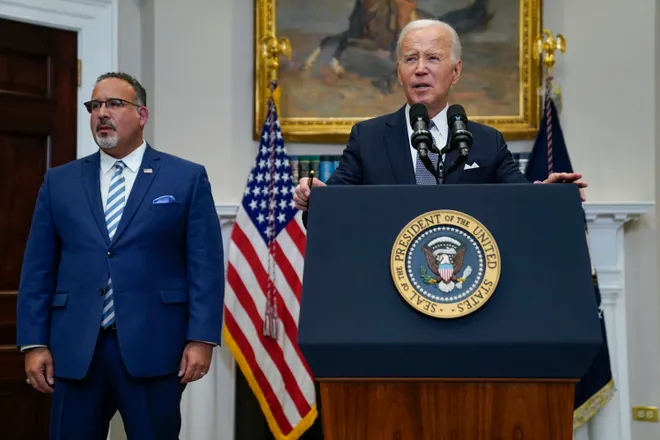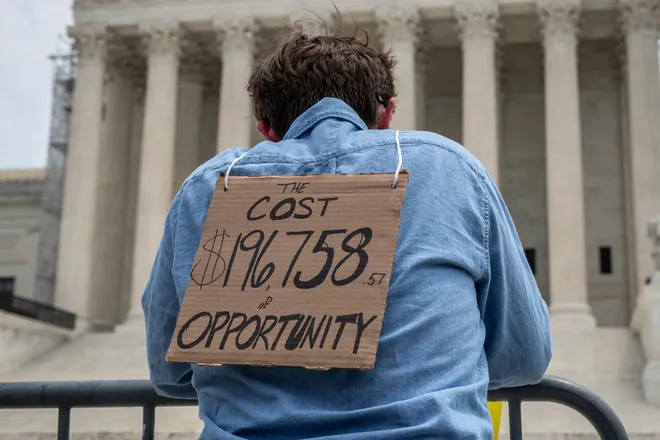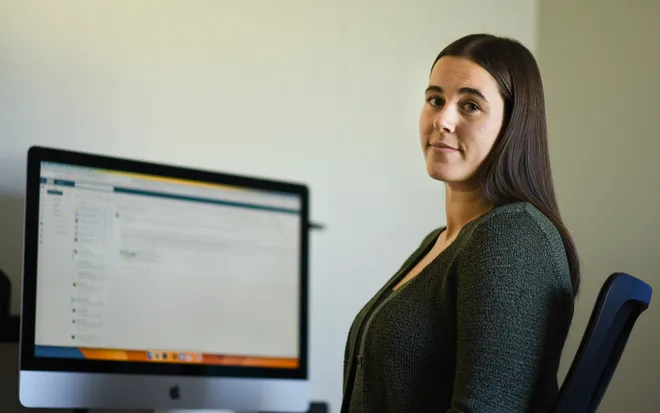Student loan borrowers face plenty of questions, budget woes, as October bills arrive
Destiny Cook, 29, assumes she'll need to juggle a $159-a-month student loan bill into her budget once payments resume this fall. The Eastern Michigan University graduate would have owed basically nothing if President Joe Biden's plan for far-reaching student loan forgiveness had not been struck down by the U.S. Supreme Court in June.
But that was the hope a year ago. Now, it's time to figure out how to pay the bills ahead.
What's most frustrating for Cook is that as of early September she still hadn't gotten a bill or even an email alert with details outlining when her payment is due and what she'd actually owe. Her loan servicer changed in the past year and emailed her earlier in the year.
She logged into her account at Nelnet, where all Great Lakes student loans were transferred in 2023, but there the information says her next payment is due Nov. 13, which really didn't make sense.
All the big headlines about student loans talked about payments resuming in October, a month before her payment would supposedly be due.
"I don't understand that date. But there's still no amount next to it," said Cook, whose loans were with Great Lakes before the pandemic-related pause. Calling her servicer was on her "to-do" list to make sure she paid in October, if she had to pay in October.
Once she got time to call and connect with the customer service team at Nelnet a few weeks later, she asked specifically why her account listed Nov. 13 as a due date? The answer was odd: “This was determined by your cycle date.” But the phone representative did confirm that Nov. 13 is correct and confirmed that she'd owe $159 per month — the same as she owed when she was with Great Lakes. All Great Lakes student loans have been transferred to Nelnet.

"It's going to be like a hot mess," Cook said, referring to the massive restart in student loan payments this fall.
How many face student loan payments again
Plenty of challenges are ahead for an estimated 40 million federal student loan borrowers as payments resume in October now that the federal student loan payment pause that stretched out roughly three and a half years comes to a halt.
About 864,000 student loan borrowers in Michigan had hoped for student loan forgiveness at some level as part of the now-dead, $400 billion forgiveness plan announced in August 2022. They now face resuming their student loan payments in the weeks ahead.
Due dates will differ but most borrowers will see their payments resume sometime in October.
In some cases, the start date can end up in November or December but that typically involves recent graduates who got their diplomas in May or June, according to Mark Kantrowitz, a student loan expert and author. Their six-month grace period would end in November or December, respectively, he said, so that's when that repayment starts.
Cook graduated in 2016 so her Nov. 13 payment date is still a stumper.
Borrowers are told by the Education Department that they will get a bill, with their payment amount and due date, at least 21 days before the bill's due date. Billing dates vary by borrower. It's best to pay attention to your own paperwork, not information from a friend.
Roughly, 1 out of 4 borrowers nationwide have a new student loan servicer and won't be dealing with the same servicer they had before the COVID-19 pandemic pause began in March 2020. Some will need to take time to figure out what they owe and when they owe it. Their first place to go is the U.S. Department of Education website at StudentAid.gov. Borrowers also can use a loan simulator there to calculate student loan payments across other repayment plans.
Michigan borrowers tend to have more student loan debt than many borrowers in other states, according to the Education Data Initiative. The average student loan debt is $36,116 in Michigan. About 52% of borrowers are under age 35. Michigan has a total student loan debt load of $51 billion, according to the Education Data Initiative.
Renters could face particular financial stress
Cutting back on spending is clearly going to be part of the picture for many people who face a restart of student loan payments after a lengthy hiatus. Money that might have been spent toward buying a car or going on vacation — or even going out to eat with friends — will be diverted back to old debts.
Young consumers who face high costs when renting an apartment or home are likely to find the restart particularly stressful, according to a report by Moody's Analytics. Some may even choose to move to lower cost housing or move in with friends or family.
Mark Zandi, chief economist for Moody's, told the Detroit Free Press that the end of the student loan payment moratorium in October is projected to reduce annualized real GDP growth in the fourth quarter by an estimated 0.2%. The impact on consumer spending and the economy, he said, will be meaningful but small when it comes to the nation's gross domestic product.
Overall, Zandi expects a soft fourth quarter, with growth at 0.8%. He's projecting a strong third quarter where the GDP grows at an annualized 2.8%. The UAW strike that began on Sept. 15 at three plants run by the Detroit Three in Michigan, Ohio and Missouri, and grew to an additional 38 plants across 20 states on Friday, could impact economic growth further, depending on how long that strike continues.
Zandi estimates that some $75 billion in student loan payments are scheduled to resume annually, with the average payment of about $300 per month. Ultimately, though, Zandi expects that much less would be paid. Several million borrowers are likely to not pay their bills and eventually go delinquent. And several million others will opt for income-driven repayment plans, such as SAVE, and be required to pay less money each month.
More:Biden's SAVE plan for student loan repayment may seem confusing. Here's how to use it.
Some borrowers can dip into savings or other sources of income to pay; others might delay resuming payments as nonpayments won't be reported to credit bureaus at this time.
Many borrowers on tight budgets aren't sure how they'll pay the bill after taking on new debt, including mortgages and car loans. Others remain stuck in lower-paying jobs and will seek ways to lower those monthly payments, including signing up for Biden's new SAVE plan.
Betsy Mayotte, president of the Institute of Student Loan Advisors, said inflation has driven many costs — groceries, rent, clothing, cars and other goods — higher than three and a half years ago when the payment pause began. And yes, some borrowers may have experienced "some lifestyle creep," she said, that will make it more difficult to fit a student loan payment back into the budget.
Mayotte's most worried about borrowers not even knowing that a repayment is due — or understanding that interest is building once again on their loans. Rates will vary based on when you took out the loan. Federal student loan rates are often in the 4% to 6% range.
Other borrowers might not realize that they can still get out of default through the end of September 2024 by signing up for a one-time, temporary "Fresh Start" initiative offered by the U.S. Department of Education. You can go to myeddebt.ed.gov or call 800-621-3115.
Borrowers in default can get back in good standing and improve their credit by enrolling in "Fresh Start" and then become eligible to sign up for a more affordable income-driven repayment plan.
Mayotte also is worried about borrowers falling for scams because they are overwhelmed by the situation and options. Or making snap decisions because they're unsure what to do or frustrated by delays in getting answers from their loan servicers.
Some borrowers will be better off, she said, aggressively trying to pay off their student loans as soon as possible. "Others will find that pursuing a forgiveness program is a better long term strategy," Mayotte said.
She expects borrowers to run into challenges, given that the restart is a once in a lifetime event.
"Tens of millions of borrowers are all reentering repayment at the exact same time," Mayotte said.
While loan servicers and the Education Department have done what they can to prepare, she said, no industry could be ready for all of their customers coming back to make payments at once with no delays. "So here we are," she said.
How to get student loan payments lower than they were in 2020
On the plus side, many borrowers will be able to deal with substantially lower monthly payments than they faced before the pandemic, thanks to efforts to encourage borrowers to consider signing up for the SAVE plan that promises affordable payments.
The new SAVE plan, launched officially in August, gets some payments down to $0 a month; others with modest incomes could be looking at payments of less than $75 month or less.
A single person without children making less than $32,800 could qualify for a $0 payment; a family of four or more with income below $67,500 could qualify for $0 payments under the SAVE plan.
In Michigan, some 143,600 student loan borrowers already are set up to reduce their monthly payments through the brand new SAVE income-driven repayment plan, according to information released Sept. 5 by the U.S. Department of Education. The figure reflects both those who signed up on their own and those who were automatically shifted over from an earlier income-driven repayment plan, called REPAYE.
More than 4 million student loan borrowers nationwide already are enrolled in SAVE.
As a nod perhaps to the reality that there will be some glitches along the way, a temporary "on-ramp" to repayment will be in place from October through Sept. 30, 2024, to protect financially vulnerable borrowers who miss payments. No action will be taken then that could result in declaring a loan in default or otherwise hurt a borrower's credit.
Borrowers are advised to resume making their payments — or sign up for income-driven repayment plans to lower their payments — as soon as possible. The 0% interest rate on student loans offered during the pandemic pause is gone; interest resumed building in September.
How the end of a car loan could help a Michigan borrower
Cook, who graduated with a bachelor's degree in public relations in spring 2016, began paying on her loans in November of that year. She's on a 10-year repayment plan at $159 a month. She's not certain but believes she started out with about $14,000 in student loans.
After the pandemic-related pause, she would have roughly six years of payments left to pay off the debt in full, Kantrowitz said.
The bulk of her $10,080 in remaining student loans would have been wiped out and forgiven under Biden's plan.
Cook remains upbeat and confident that she'll figure out how to come up with the extra cash each month.
She expects she'll give up spending on some little things, like coffee and maybe not eating out as often. It won't hurt, either, her 60-month car loan at $567 a month will be paid off in September, too. She bought a 2018 Jeep Compass. She will use that money toward savings and put more money each month than what her payment requires toward her college debt to pay it off quicker.
"I don't feel super stressed out about it," said Cook, who is a senior public relations specialist for the University of Michigan School of Public Health.
She isn't dealing with high rent or a mortgage. She's living at home in Tecumseh with her mom. Only drives into Ann Arbor for her job about twice a month. She makes roughly $70,000 a year. She's not married and has no children.
And she's also thankful that she put a lid on her total student loan borrowing by attending Washtenaw Community College for the first two years when she had no clue what major she wanted to pursue in college.
Her mother paid for Cook's community college bills out of pocket. Her mother also took out loans when she went to Eastern but her mother has paid those loans off.
Cook paid a bit of money toward her own student loans during the pandemic but she ended up asking for a partial refund, as she could, last year when it seemed like she qualified for $10,000 in student loan forgiveness under Biden's plan.
Cook was disheartened on news of the Supreme Court's 6-3 majority ruling that the Biden administration overstepped its authority by pushing forward with its costly debt relief plan.

For many borrowers, repayments would have resumed now even if the Supreme Court allowed forgiveness plans to go through. Many borrowers owed much more than the debt that would have been forgiven.
As part of negotiations in Congress in May to raise the nation's debt ceiling, a deal was struck on ending the payment pause that began in March 2020 as part of economic-relief efforts during the pandemic.

More:Michiganders react to Supreme Court rejecting student loan forgiveness plan
More:US Supreme Court blocks student loan debt forgiveness: What happens now
Under the sweeping Biden forgiveness plan, which was struck down by the Supreme Court, many borrowers with an annual income during the pandemic of under $125,000 for individuals — or under $250,000 for married couples — would have been able to see up to $10,000 in federal student loans forgiven.
If they had a Pell Grant in college, they would have been eligible for up to $20,000 in debt cancellation under the forgiveness plan that the Supreme Court rejected.

Cook researched the new SAVE plan to lower her monthly payments on her undergraduate student loans but from what she saw her monthly payment wasn't going down and looked like it could go up for her under SAVE based on her steady income, lower level of debt and lack of dependents.
"It wasn't as simple as it was made out to be in the initial email from the Department of Education," she said.
Most borrowers will see their payments lowered by the SAVE plan, but not everyone. Borrowers need to study their own numbers at an online loan simulator at StudentAid.gov/loan-simulator. See StudentAid.gov/save to study the details relating to the SAVE plan.
But again, Cook acknowledged, she feels OK going forward.
"$159 isn't hurting me. I'm not in crippling student loan debt," Cook said. "I cannot do other things if I am really hurting to pay for these loans."
More:Thousands of Michigan student loan borrowers already signed up for new SAVE payment plan
Why many young borrowers will go out less often
Many borrowers face bigger bills and far fewer options.
Samantha Diehl, 29, of Lansing, expects that she'll end up trimming back on streaming services, which now cost her about $55 a month, and going out with friends or eating out.
She took time to seriously review her old bills and totaled up that she's been spending about $500 eating at restaurants. Not any more if she's to pay $313 a month on her student loans. Her first student loan bill is due Oct. 9. Her highest interest rate on her loans is 4.66%.
Diehl, who graduated in 2017 from Michigan State University with a degree in kinesiology, is a communications manager for Meridian Township and owes about $21,400 in federal student loans.
She had Pell Grants in college and would have qualified for seeing $20,000 in student loans forgiven under the now-defunct Biden forgiveness plan. But that's no longer on the table.

She has other expenses that she can't cut: Her rent, around $1,005 for a one-bedroom, one-bath flat in downtown Lansing. Her utilities that add up to around $170 a month. She's single and has no children. She makes about $60,000 a year.
During the payment pause, she took out a car loan in early 2022 with a payment of $222 a month to buy a used 2015 Jeep Cherokee TrailHawk. She has been paying $300 a month on the car loan to pay down that debt more quickly.
She figures she can pay the student loan bill, though, if she sticks to a much tighter spending budget. Right now, she's not planning to turn to the SAVE plan.
"I know what to expect, but now I'll just have to implement it," Diehl said.
Contact personal finance columnist Susan Tompor: stompor@freepress.com. Follow her on Twitter @tompor.
Disclaimer: The copyright of this article belongs to the original author. Reposting this article is solely for the purpose of information dissemination and does not constitute any investment advice. If there is any infringement, please contact us immediately. We will make corrections or deletions as necessary. Thank you.







